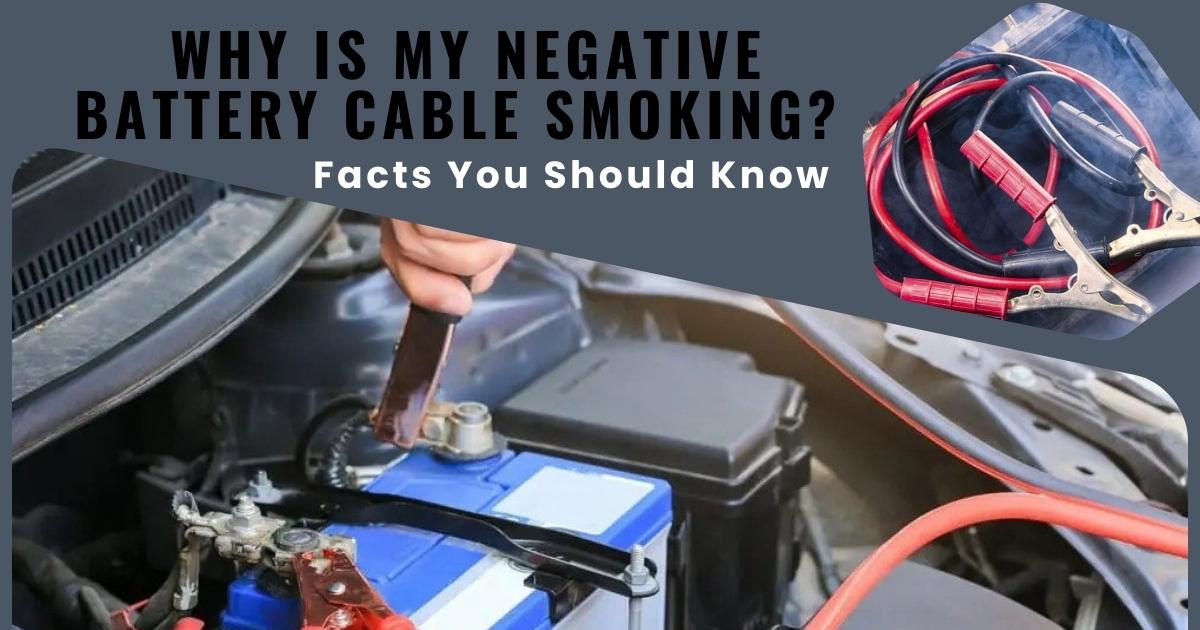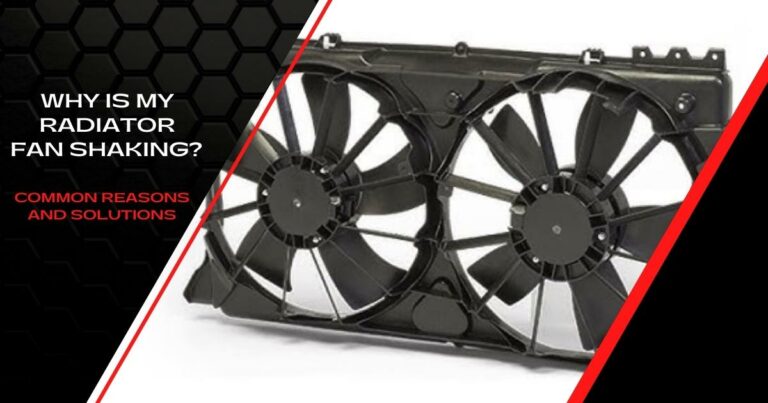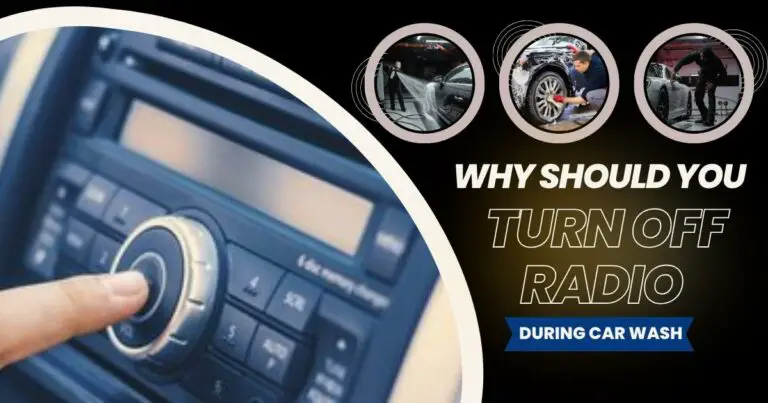Why is My Negative Battery Cable Smoking? Facts You Should Know
The sight of a smoking negative battery cable can be a cause for concern and confusion for many vehicle owners. Most people are naturally worried about the well-being of their vehicle and, in most cases, their safety.
The negative battery cable allows electrical current to flow between the battery and various components in the car. When you see smoke coming from this cable, it’s a clear sign that something’s wrong, and it needs your immediate attention.
Today, we’ll look into the common causes of negative battery cable smoking and the steps you can take to diagnose and rectify the problem.

Why is My Negative Battery Cable Smoking?
The negative battery cable is a fundamental component in a vehicle’s electrical system. It acts as the lifeline for your vehicle by providing power to various systems and devices. Now, when an issue arises with your negative battery cable, it can have far-reaching consequences.
A smoking negative cable can disrupt the flow of electricity, leaving important components without power. This might make your car battery seem dead, even if it is fully charged. Getting to the root cause of the problem is important to prevent further damage, ensure your safety, and maintain the proper function of your car.
Having said that, let’s discuss some of the factors that can make your vehicle’s negative battery cable produce smoke.
Overheating
Overheating is a common factor that can make the negative battery cable emit smoke. This occurs as a result of the excess heat generated during the regular operation of a vehicle’s electrical system, particularly when the battery is charging or discharging at an accelerated rate.
Generally, the electrical system entails a constant transfer of power, particularly when charging the battery or discharging energy to power various components. Under normal circumstances, this process generates some heat. However, certain situations can cause this heat to escalate to a point where it becomes a concern.
One of the most typical scenarios is when the battery is rapidly charging or discharging. This can happen, for instance, during frequent and abrupt starts and stops, which demand a quick release of power from the battery.
As a result, the electrical system is forced to work harder to manage the power fluctuation. This can lead to an excessive buildup of heat, which can affect the negative battery cable and, in the process, make it emit smoke.
Corrosion
Corrosion is another factor that can make the negative battery cable emit smoke. When the terminals or cable connections become corroded, they create a layer of resistance that can restrict the flow of electricity. This resistance makes the cable work harder to maintain the current. In severe cases, the corrosion can result in heat buildup as the cable struggles to maintain the electrical circuit. If the heat becomes excessive, it can lead to negative battery terminal smoking.
Short Circuits
Short circuits are another reason why the negative battery cable might smoke unexpectedly. When a short circuit occurs, it disrupts the normal flow of electricity, often leading to an abnormal and unrestricted path for the electrical current. This can result in heat generation, damage to insulation or wiring, and, in some cases, battery terminal smoking.
Loose Connections
Loose or poor connections can make the negative battery cable malfunction and, in severe cases, emit smoke. When your connections are loose, they may not provide a secure and efficient path for electrical current. This can lead to an increase in resistance within the electrical circuit. As a result, the cable might generate heat causing it and other nearby components to overheat and, in severe cases, emit smoke.
Excessive Electrical Load
Drawing an unusually high amount of power from the electrical system can strain the system and the negative cable in particular. One common cause of excessive electrical load is the addition of aftermarket accessories that draw a substantial amount of power.
As the system attempts to meet these heightened power demands, the negative cable may be forced to carry more current than it was designed for. This can result in increased heat generation within the cable, leading to overheating and the battery terminal smoking when trying to start the vehicle.
Alternator issues
The alternator is responsible for generating electrical power and charging the battery during the operation of the vehicle. It is composed of various components, including the diodes, voltage regulator, and brushes. Over time, these components can wear out, become damaged, or fail, leading to overheating and smoking.
The alternator getting hot and smoking can make the generated heat be transferred to nearby components, including the negative battery cable. If the cable is close to the alternator or runs through areas of high heat, it can absorb some of this heat. This can, in turn, make the cable overheat and possibly make the insulation melt or emit smoke.
Troubleshooting Negative Battery Cable Smoking
When you observe the negative battery cable emitting smoke, it’s a clear indication that there is an issue within your vehicle’s electrical system. Failing to address this problem can lead to various consequences including;
- Safety Hazard- A smoking negative battery cable can pose safety risks, including the potential for electrical fires. The cable can catch fire easily which can endanger your well-being and the safety of others on the road.
- Electrical System Damage- Running the vehicle with a smoking negative battery cable can cause irreversible damage to the electrical components and wiring in your vehicle. In most cases, repairing such components can be costly.
- Vehicle Breakdown- Ignoring a smoking cable can lead to a breakdown of your vehicle when you least expect it. This can be inconvenient, especially in adverse conditions or inconvenient locations.
- Electrical Shocks- A smoking cable can also lead to electrical shocks if you don’t handle it properly. As such, it is crucial to exercise extreme caution and prioritize safety when dealing with the cable to prevent any risk of electrical shocks.
How to Fix Negative Battery Cable Smoking
Visual Inspection
The first step you’ll need to take when troubleshooting a smoking battery cable is to examine the cable for visible damage. Check the entire length of the cable for any melting, fraying, or physical damage. Melting or fraying can occur when the cable has been exposed to excessive heat, leading to insulation damage or exposed wires.
Examine the cable connections, particularly at the battery terminals and other electrical components. Ensure that the connections are secure to prevent overheating and other electrical problems. You may also want to look for any discoloration, scorch marks, and other signs of overheating along the cable.
Inspect for Short Circuits
Carefully examine all the wiring and connections in your vehicle, especially those in the vicinity of the negative battery cable. Look for damaged or exposed wires, loose connections, and signs of burning or melting.
Pay close attention to the insulation on wires. If you find wires that are touching or exposed, carefully separate them and insulate the affected areas with electrical tape or heat-shrink tubing. You may also want to secure or fasten the cable to prevent it from moving or rubbing against other wires.
Monitor the Alternator
Ensure your vehicle’s alternator is functioning as expected and not overcharging the battery. Overcharging can generate excessive heat and damage the battery and its connections. Also, ensure to check the condition of your vehicle’s battery regularly. If the battery is damaged or old battery it might not hold a charge, causing the alternator to work harder and generate more heat.
Avoid Overloading the Battery
Be mindful of the electrical load on your vehicle, especially if you use aftermarket accessories. Ensure your vehicle’s electrical system can handle the added load without straining components like the negative cable and the alternator.
Proper Installation
Ensure that the negative battery cable is properly installed and fastened securely. Ensure the cable is routed and positioned correctly to avoid any sharp edges, hot surfaces, or moving parts that could cause abrasion or damage to the cable.
Before attaching the cable, make sure that the battery terminals are clean and free from corrosion. You can use a battery terminal cleaner or a wire brush to remove any buildup on the terminals. Clean terminals facilitate a better electrical connection, which prevents issues in the future.
Replace the Cable
If the cable is damaged and cannot be repaired, you’ll need to replace it with a new one. Once replaced, you may want to inspect the new cable periodically for wear and damage and address any issues promptly to prevent a recurrence of smoking or overheating.
Parting Shot!
Unlike some regular maintenance tasks, such as oil changes, there’s no set schedule for checking the condition of the negative battery cable. However, it’s always a good idea to inspect the cable as part of your routine vehicle maintenance. This will go a long way in identifying issues early enough and preventing unusual smoking down the road.







